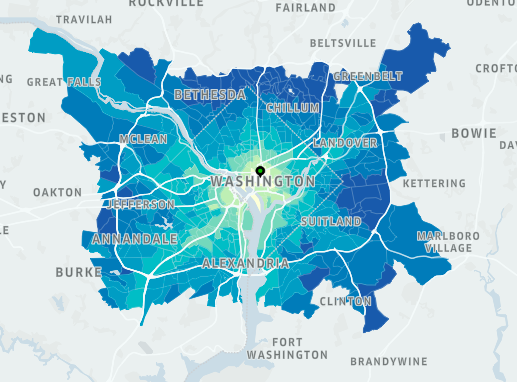What City Observatory did this week
1. Inequality in three charts. New data produced by Thomas Piketty and his colleagues provides a rich, high-definition look at the growth of income inequality in the US. But while the quality of our understanding of the inequality problem has improved, it’s apparent that the growth of inequality in the US has been obvious for more than a quarter century. It’s also interesting to compare inequality in the US to global trends. While the US income distribution is more unequal, global incomes have mostly tended toward greater equality, chiefly due to rapid economic growth in Asia. The worst income growth has been recorded by those in the bottom-half of the income distribution in richer, Western countries.
2. A peek at Uber’s ride-hailing data. Ride-hailing companies like Uber and Lyft have been notoriously reluctant to share the copious travel data generated by their activities. Uber has lifted the veil just a bit, and begun publishing travel time data through a new portal called “Movement.” Movement allows users to monitor variations in travel times between any two points in a metro area by time of day and over a period of several months or years. It can help answer questions about whether travel times on city streets are getting shorter or longer. There are some key limitations: data is richest in dense urban spaces (where Uber provides most of its rides) and so far only a handful of cities are available, including Boston and Washington. Still, its a great tool, and we hope Uber expands it to all the cities it serves, and continues to make comparable data available over time.
Must read
1. As Philadelphia’s center city population grows, demand for parking declines. Inga Saffron has a terrific article descrbing how garages and parking lots in Philadelphia’s center city are being converted to new housing. And remarkably, the demand for car storage in these increasingly populous urban neighobrhoods is going down. Population in the city center is up 16 percent since 2000, but the occupancy rate of city center garages, which peaked at about 78 percent in 2005, is down to about 74 percent. Saffron attributes the decline to the growing density of commercial activity in walkable neighborhoods and the advent of ride-hailing services; fewer than half of center city residents own cars. One problem remains: because the city underprices street parking — annual permits cost just $35 –the streets are full of parked cars.
2. Harvey and Houston’s non-zoning regime. It’s apparent that the damage wrought by Hurricane Harvey was amplified by Houston’s sprawling development, which covered over water absorbing land, and accelerated the rate of runoff from roofs, roadways and parking lots. As Daniel Hertz explains, while Houston doesn’t have zoning per se, other features of its system for regulating development encourage sprawling, low-density growth. The city prescribes and enforces minimum off-street parking requirements and mandates wide roadways, all of which increase impervious surfaces and runoff.
3. Climate change: Fight or adapt. Writing at Pedestrian Observations, Alon Levy takes a critical view of strategies to promote adaptation in the face of climate disruption. Many rich, low lying-communities around the world have the resources to adapt to rising sea levels, more violent storms, and hotter weather. But while the rich can take refuge behind flood walls or air conditioning, the world’s poor don’t have those choices. At the same time dozens were dying due to Hurricane Harvey in Houston, 1,200 perished in floods associated with unseasonably strong monsoons in India and Bangladesh. In essence, adaptation is tantamount Choosing adaptation over fighting climate change more aggressively is tantamount to climate apartheid, with safety for the rich, and vulnerability for the poor.



